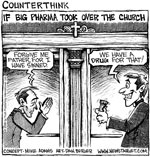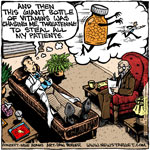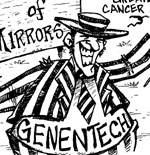Pyridoxal 5-Phosphate Benefits - Banning B6 Backfires in Unexpected Way
| Share on Facebook | Share on Twitter | Share on Google+ |
As you will read a little later in this article, vitamin B6 is one of the most useful general health tools known to nutritional science. It has applications in fighting many and perhaps all of the diseases of aging, including Alzheimer's, carpal tunnel syndrome, cataracts, depression, diabetic neuropathy, kidney failure, acne, wrinkles, and hair loss, among many others. Modern nutritional formulas give you a kind of vitamin B6 that your body can use right away-but nutritional supplement makers had to figure out a way to give you this supercharged form of B6 after the US Food and Drug Administration took the regular kind of B6 away.
Vitamins versus Vitamers
A vitamin is a group of substances that we can't live without, that we have to get from outside our bodies, that perform related tasks in the body, and that are to some degree interchangeable with each other. A vitamer is any one of the substances that makes up a vitamin.
E, for instance, is a vitamin. Alpha-tocopherol, beta-tocopherol, gamma-tocopherol, delta-tocopherol, alpha-tocotrienol, beta-tocotrienol, gamma-tocotrienol, and delta-tocotrienol are vitamers. B6 is also a vitamin, and its vitamers are pyridoxine, pyridoxamine, pyridoxal, and pyridoxal phosphate. The latter chemical is the active form of vitamin B6, usually identified by its chemical name, pyridoxal 5-phosphate.
What's the difference between vitamin B6 and its vitamers? Here's a quick overview:
- Pyridoxine is the "storage form" of vitamin B6, the kind that is found in whole grains, seeds, and other plant foods. Pyridoxine is the most shelf-stable form of the vitamin. The body activates it by changing it to pyridoxal 5-phosphate.
- Pyridoxal is another "storage form" of vitamin B6, the kind that is found in meat, fish, and dairy products. The human body can also change this form of vitamin B6 into the active form of the vitamin, pyridoxal 5-phosphate.
- Pyridoxamine is a chemical combination of pyridoxine and pyridoxal. The body can break it down it into pyridoxine and pyridoxal and then into the active form of B6.
- Pyridoxal 5-phosphate is the form of B6 the body actually uses. Strictly speaking, there is no such thing as a recommended pyridoxal 5-phosphate dosage or a pyridoxal 5-phosphate deficiency, since our bodies make this specific chemical. Dosages are measured for the pyridoxine that is most commonly found in food.
Pyridoxamine, however, has some functions in the body that pyridoxine and pyridoxal do not. Pyridoxamine is a chelating agent. It can interact with and trap heavy metals. And, more importantly, it can block the aging effects of sugar.
Pyridoxamine and Reversing the Aging Process
One of the causes of aging, especially in the skin, is the formation of "advanced glycation end-products." Any cell in the body can become essentially sugar-coated by interaction with glucose from the bloodstream. In diabetics, of course, the problem is much worse, since there is more sugar in the bloodstream to "caramelize" cells.
The sugar on these cells is not a problem until it begins to break down. The advanced glycation end-products release tremendous amounts of free radicals, so many that the cell's energy center, the mitochondria, "burn out" when they use oxygen to make energy. The cell dies, and when enough cells die, tissues and organs don't function as well.
This is the underlying chemical process beneath wrinkling, cataracts, atherosclerosis, certain kinds of kidney failure, the complications of diabetes, and possibly Alzheimer's disease (although there are other kinds of cell destruction also involved in Alzheimer's). Stopping the formation of advanced glycation end products, if started soon enough, stops these diseases of aging.
That's where pyridoxamine comes in. It stops a kind of chemical reaction known as the Maillard reaction. You may not know the chemistry, but you have definitely seen a Maillard reaction in the real world. This combination of sugars and amino acids is what makes toast brown, or tater tots crunchy when they've been fried, or puts the "burn" on roasted meat or barbecue, or gives maple syrup its brown color. At a cellular level, pyridoxamine keeps your cells from becoming toast.
It's so useful you would think someone might try to patent it. And someone did.
Why the FDA Took Pyridoxamine Away from the Supplement Industry
In 2004, the pharmaceutical company Biostratum filed a patent for a new drug called Pyridorin. Early clinical trials showed that their formula had stopped the progression of nerve damage in diabetics. Its active ingredient, it turned out, was the pyridoxamine vitamer of vitamin B6.
The company stopped the final testing of their drug when they found out that people could buy pyridoxamine over the Internet. They demanded that the US Food and Drug Administration ban the sale of pyridoxamine-which is something that is found in food-as an "investigational drug," because under a technicality in US law, if something hasn't been sold as a supplement before 1999, it's a drug.
The FDA agreed and banned the sale of pyridoxamine as a supplement. Ironically, Biostratum had run out of money and will never be able to sell pyridoxamine as a treatment for diabetic neuropathy or anything else. But the FDA wanted to make sure that vitamin companies can't profit when the pharmaceutical companies can't, so they made this form of B6 unavailable to everyone in the US. And since the US is a huge market, many companies simply won't try to sell a vitamin formula if they can't sell it in the US. However, there turned out to be another way.
How the Supplement Industry Reformulated a Potent Form of Vitamin B6: Pyridoxal 5-Phosphate Benefits
For a short time, the makers of vitamin supplements did not know how to package the potency of vitamin B6 into a vitamin pill. Pyridoxine and pyridoxal in higher doses have the same effects as the now-banned pyridoxamine, but the body has to activate them into a glycation-fighting form. Then the companies that make the vitamins figured out a way to make pyridoxal 5-phosphate, a ready-to-work vitamer of B6.
Most companies in the Western world get their supplies of pyridoxal 5-phosphate from a Japanese-owned company in Cape Giardeau, Missouri, called Kyowa Hakko USA. There is no worry about contamination of the product, and it's priced in US dollars-which for much of the world keep the cost of the product down. And although the scientific world has been slow to generate the same level of proof for pyridoxal 5-phosphate that it had already for pyridoxamine, clinical research is coming in that shows that it prevents the most dreaded complication of uncontrolled diabetes, kidney disease, and for heart disease, and seizures, and for hardening of the arteries.
In fact, it turns out that pyridoxal 5-phosphate may actually turn out to be better than pyridoxamine at stopping the product of advanced glycation end-products that cause so many of the diseases of aging:
In one study, the pyridoxine form of vitamin B6 stopped about 10 per cent of glycation end products. The now-banned and once promising pyridoxamine form of vitamin B6 stopped about 20 per cent of glycation end products. But the pyridoxal 5-phosphate form of vitamin B6 stopped about 80 per cent! Let's just hope no one at the drug company headquarters has been reading the research about the form of vitamin B6 that really works.
Pyridoxal 5-phosphate is pricey as an ingredient. Vitamin manufacturers pay a lot more for it than they pay for pyridoxine and pyridoxal. But for the best results, it's a must in any vitamin B formula, along with folic acid and vitamin B12.
Selected References:
Morris MS, Sakakeeny L, Jacques PF, Picciano MF, Selhub J.
Vitamin B-6 intake is inversely related to, and the requirement is affected by, inflammation status. J Nutr. 2010 Jan;140(1):103-10. Epub 2009 Nov 11.
Shen J, Lai CQ, Mattei J, Ordovas JM, Tucker KL. Association of vitamin B-6 status with inflammation, oxidative stress, and chronic inflammatory conditions: the Boston Puerto Rican Health Study. Am J Clin Nutr. 2010 Feb;91(2):337-42. Epub 2009 Dec 2.
-
Skin CareMen Skin Care
-
Free ResourcesFree eBooks
-
Let food be thy medicine, and let thy medicine be food.Hippocrates
-
Featured Health SupplementTotal Balance is like no other
 … in that it utilizes state of the art delivery systems not generally used in a supplement...
… in that it utilizes state of the art delivery systems not generally used in a supplement...
-



















